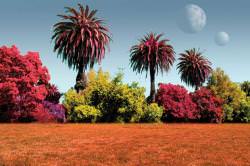We’ve already found over 250 extrasolar planets, and more are continuing to be discovered fairly often. With all of these new planets popping up, the obvious question must be asked: how do we go about detecting whether or not they contain life? Though we can’t yet see features on the surface with even the most powerful of telescopes – and probably won’t be able to do so for a very long time – an analysis of the light coming from the planet may reveal if it is covered with life in the form of plants.
Dr. Luc Arnold of the CNRS Observatoire de Haute-Provence in France suggests that a spectral analysis of the light reflected off of a planet could determine whether or not it is covered with vegetation.
Earth’s plant-covered surface absorbs certain frequencies of light, and reflects others. Our vegetation has a very specific spectrum because it absorbs a lot of visible light around 700 nanometers, or the color we see as red. This is called the Vegetation Red Edge (VRE).
By looking at the sunlight that is reflected off of the Earth – Earthshine – the composition of the Earth’s surface and atmosphere can be determined. The Earth’s light can be analyzed when it is reflected off of the Moon, or from spacecraft distant enough from the Earth to see it as a small disk.
Knowing the composition of the Sun’s light, and adjusting for the elements and minerals in the atmosphere and on the surface, there is still between 0-10% of the photons near the red end of the visible spectrum that are missing. The factor needed to explain this photon absorption is the presence of plants, which use the light for photosynthesis
This same method could potentially be used to detect the presence of vegetation on extrasolar planets, proposes Dr. Arnold in a paper titled, Earthshine Observation of Vegetation and Implication for Life Detection on Other Planets published in the October 30th, 2007 edition of the journal Space Science Review.
“The point is that if, in the spectrum of an Earthlike planet, we find a spectral signature –probably different than the VRE – that cannot be explained as a mineral signature, nor an atmospheric signature, then the proposition that this feature is a possible signature of life becomes relevant. Especially if a variation in the strength of the signal is correlated with planet’s rotation period, suggesting that the spectral feature is on planet’s surface,” Dr. Arnold said.
The VRE on Earth is calculated by taking out “noise factors” such as the composition of the atmosphere, whether there are a lot of clouds, and whether the part of the Earth reflecting the light is covered by desert, ocean, or forest. All of these things absorb light in different parts of the spectrum. These same details must be sorted out for other planets to ensure that the absence of photons in a certain part of the spectrum is indeed due to plants absorbing the light.
To be able to rule out other factors in the spectrum of the planet, the resolution has to be better than is currently possible. ESA’s Darwin and NASA’s Terrestrial Planet Finder, both missions being designed to specifically look for new terrestrial planets and better study already-discovered ones, are expected to launch in the next 10 years or so. They will not be able to resolve the spectrum of extrasolar planets well enough to use this method for finding vegetation, but the second-generation of planet-finding telescopes will likely have this ability.
The question remains as to whether plants on distant worlds will use chlorophyll as their means of photosynthesizing light. Will the light they absorb be red, or a different color? Will the light they reflect be green or something completely bizarre, like magenta or bright blue? If they do use chlorophyll, their spectrum will be similar to that of our own planet. If not, their spectral signature may be rather different than that of Earth’s vegetation.
Dr. Arnold says a different VRE might still be rather interesting: “What would we say to us such a strange and different VRE ? It will reveal missing photons, i.e. photons form the star absorbed and ‘used’ (their energy) in an unknown or unidentified chemical process, that’s all we would learn. Here again, other information about the atmosphere composition (water vapor, oxygen, ozone, etc.) and temperature would help to make coherent proposals. At least it would feed an very exciting debate!”
Source: Space Science Review


First we should analyze the spectral light from earth preferably at an observatory at moon or Mars.Over there we should conduct various tests on that spectral light and then we should search for similar extrasolar planets.
This article and the efforts behind it make a huge number of assumptions. We should be more inclined to uncover the mechanisms of current life on earth before assuming DNA, cell based vegetation exists elsewhere.